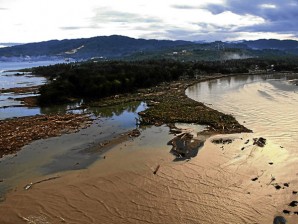‘Sendong’ death toll passes 900 as cities prepare burials

SILENT SCREAM This seemingly peaceful seascape is what remains of Bayug Island after rampaging floodwaters from the Mandulog River smashed through it early Saturday morning at the height of Tropical Storm “Sendong.” A settlement of Hinaplanon village, 3.7 kilometers northeast of the Iligan City poblacion, Bayug is considered the first Christian community in Iligan City. Before Saturday, it was home to 341 families. Only 100 families have been accounted for. The rest are missing and feared dead. RICHEL V. UMEL / INQUIRER MINDANAO
ILIGAN CITY, Philippines—The death toll from the cyclone disaster that swept the southern Philippines has jumped above 900, a senior government official said Tuesday, as cities prepared mass burials for the victims.
Authorities in the port cities of Cagayan de Oro and Iligan, on the island of Mindanao, where sleeping families were swept to sea from coastal slums, said unclaimed corpses piling up in mortuaries were posing health risks and had to be interred.
The head of the government disaster monitoring council said 927 people were now known to have been killed by tropical storm Washi, which brought heavy rains, flash floods and overflowing rivers to Mindanao.
The death toll is expected to rise even further as more floating bodies are recovered after sunrise, said Benito Ramos, head of the National Disaster Risk Reduction and Management Council.
Ramos’s latest toll was a sharp increase from the council’s previous figures of 662 dead and 82 missing issued just hours earlier. The Philippine Red Cross, which is doing its own tally, reported 713 dead and 563 missing.
“They (the dead bodies) were washed out to sea. They were underwater for the first three days but now, in their state of decomposition, they are bloated and floating to the surface,” Ramos told AFP.
“The death toll will rise again (in the morning) when more bodies surface.”
The huge death toll came as government relief workers recovered more bodies from Mindanao, particularly Cagayan de Oro and Iligan, which have borne most of the deaths from Washi.
A British national was among those killed by the storm, Britain’s Foreign Office said on Monday.
Whole villages perched on sandbars or on the shores of rivers were washed away when Washi struck Mindanao and nearby areas over the weekend, bringing a month’s worth of rain in a 24-hour period.
The disaster area, located about 800 kilometers (500 miles) from the capital Manila, is normally bypassed by typhoons that ravage other parts of the far-flung Philippine archipelago every year.
As a result, many residents were caught by surprise when floods suddenly hit their homes in the dead of night, before dawn on Saturday.
More than 88,000 people have been displaced by the storm with over half of them huddled in crowded, makeshift government evacuation centres, the disaster management council said.
Teresita Badiang, an engineer at Iligan mayor’s office, said the city had begun constructing two concrete communal tombs where cadavers would be placed side by side “so that their burial will be dignified.”
In Cagayan de Oro, where the disaster council placed the death toll at 336, Mayor Vicente Emano said a mass burial would be held within the week.
Dr Jaime Bernadas, the department of health’s director for the region, said cadavers were still being processed prior to “temporary burial” in the city.
Health officials were taking DNA samples and photographs of victims.
Dr. Eric Tayag, head of the national epidemiology centre in Manila, said the government was taking steps to prevent outbreaks of cholera, dysentery, dengue and respiratory problems particularly in congested evacuation centres.
“Around 10 days after this flooding there might be an epidemic of water-borne diseases,” Tayag warned on television.
President Benigno Aquino III is set to visit the stricken zone on Tuesday after ordering a review of the country’s disaster defences.
Getting a full accounting of the dead and missing is difficult as most of the victims were “informal settlers” — a term typically used for slum squatters and internal migrants who are often unregistered by authorities.
Authorities likened the impact of tropical storm Washi to Ketsana, one of the country’s most devastating storms which dumped huge amounts of rain on Manila and other parts of the country in 2009, killing more than 460 people.














